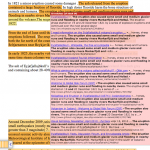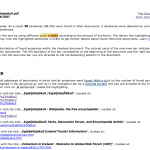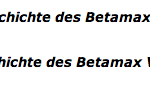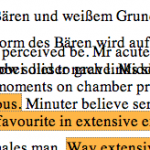Software Profile | Description | Pros & Cons | Report | Usability | Summary | Screenshots | Links
Software Profile
| ID | S13-07 |
| Product | Docoloc |
| Company | Docoloc UG & Co. KG Methfesselstraße 2 38106 Braunschweig Germany email: info@docoloc.de Telephone +49-531-3495570 |
| Web-Site | http://www.docoloc.de |
| Software-Type | Online |
| Pricing | Minimum 276 € per year for institutions, free version available |
| Testdate | 18 April 2013 |
Description
Docoloc is offered by the German company Docoloc UG & Co., located in Braunschweig. It is offered in a free demo version and a paid professional one. In the free version, only a small portion of the file is actually checked, the premium version is said to test the entire document. The system is only available to educational institutions, not for individual use so that students cannot use it.
Docoloc is used as the search engine by the Open Access Plagiarism Search service (OAPS). Docoloc itself can use that database, as well as its own. It does not give information on the size of the database on the web page.
Pros & Cons
It is possible to upload multiple files at once and they can be in any format. The user can also delete files that have already been checked, it is not clear if these files are still stored in the Docoloc database or not.
The design of the site is reminiscent of Google but not well thought out. There is also some German/English confusion, as clicking on a link that is in English will occasionally bring up a German page and vice versa. The system does not report any percentages, but only the number of sentences that could contain plagiarism. The Hebrew source was not found, neither could the system find a source from Google Books. It identified more plagiarized sentences in the large files than in the smaller files, although the text of the plagiarism was identical in both.
Report
The report is extremely confusing. First, a long list of potential sources is given with the number of sentences that were found in that source listed. Sometimes the same source is listed twice with a different number of sentences found, which is quite confusing. Clicking on the source now opens up a page with marked sentences. Little flying windows open up over the marked sentences. Even if only a portion of the sentence is in the source given, the entire sentence is highlighted. The sources are only linked in the flying window, they must be opened separately. Since there is no marking in that document and more of the sentence is potentially marked than is found in the source, it can be very trying to document the plagiarism.
The report cannot be stored, this makes it quite useless as documentation for an examination board.
Usability
The system is quite confusing to use. Although the files are uploaded rapidly, it takes a good bit of time for the reports to be generated. The interpretation of the results is not easy to understand and quite difficult to navigate. The system switches between English and German at times. The system also logs users out after a certain amount of time, something that is just irritating.
Summary
With only 54% of the points, the system did not find much in the way of sources for the plagiarism. Since the usability of the system is still so problematic – although this has been reported on a number of times – the system was evaluated as only marginally useful for academic purposes.
Screenshots
- Docoloc’s Homepage
- Report view in Docoloc
- No percentages for individual sources in Docoloc
- Same source listed twice in Docloc
- Occasional, bizarre formatting errors do not increase the trust in the system





